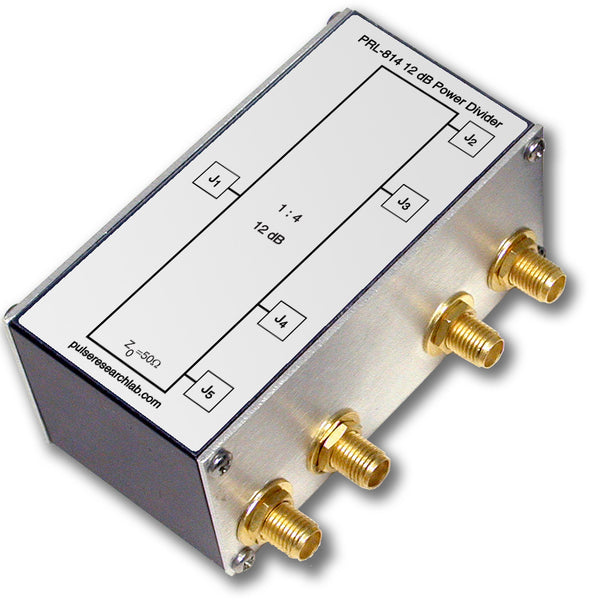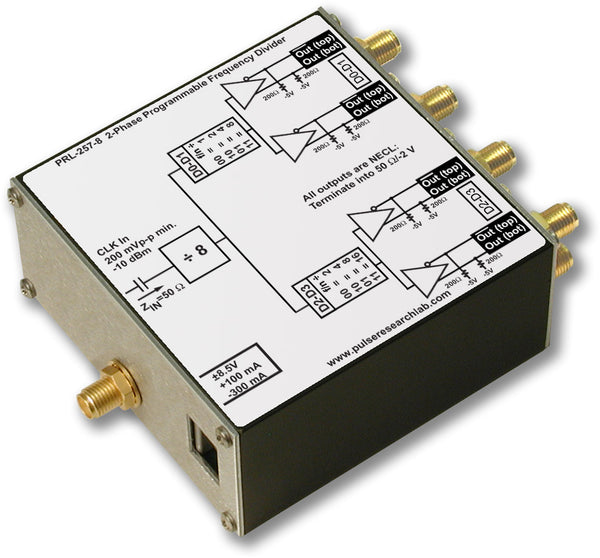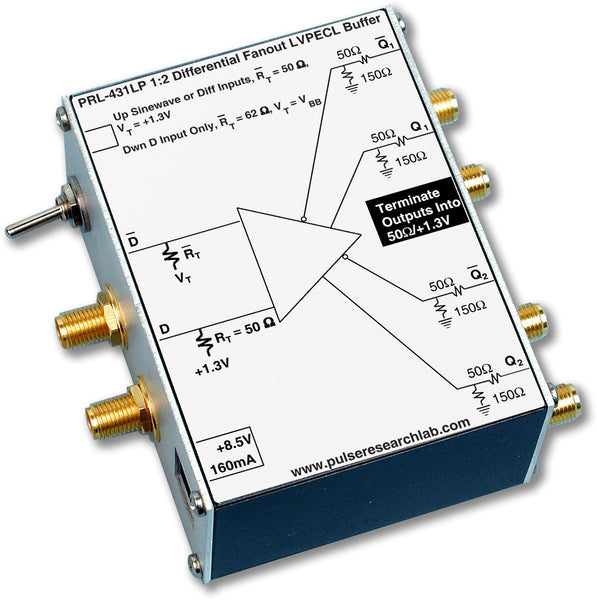Applications:
|
|
Features:
|
|
DescriptionThe PRL-430LP is a dual channel, differential/ single-ended input LVPECL receiver module with complementary outputs. It is intended for converting single-ended signals, including GHz sine waves, into differential LVPECL signals for driving long lines and for receiving differential signals from long lines. A switch selects either single-ended or differential inputs, as shown in Fig. 1. In the differential input mode, both inputs D and D are terminated internally into 50 Ω/+1.3 V, and, therefore, either one or both inputs can accept AC coupled signals as well. In the single input mode, signals should be connected to the D inputs only. The D inputs are switched internally to VBB, nominally +2.0 V, and termination resistors RT for the D input channels are changed to 62 Ω. Complementary outputs of the PRL-430LP are designed for driving 50 Ω loads terminated into +1.3 V. With internal pull-down resistors these outputs can also be AC coupled for driving 50 Ω loads terminated to ground or to other voltages. The PRL-430LP complementary outputs must be used together for driving differential LVPECL inputs only, because the reduced output logic swing of 400 mVPP (for short circuit protection reasons) is not logic level compatible with some single-ended LVPECL inputs. The PRL-430LP is housed in a 1.3 x 2.9 x 2.2-in. extruded aluminum enclosure and supplied with a ±8.5 V/1.8 A AC/DC adapter. |

(0° C ≤ TA ≤ 35° C)*
| Symbol | Parameter | PRL-430LP | UNIT | ||
|---|---|---|---|---|---|
| Min | Typ | Max | |||
| RIN | Input Resistance | 49.5 | 50.0 | 50.5 | Ω |
| VTT | D Input Termination Voltage (fixed) | 1.18 | 1.30 | 1.43 | V |
| VT1 | D Input Termination Voltage | 1.18 | 1.30 | 1.43 | V |
| VT2 | D Input Termination Voltage (variable) | 1.80 | 2.00 | 2.20 | V |
| VIL | Input Lo Voltage | 1.35 | 1.48 | 1.67 | V |
| VIH | Input Hi Voltage | 2.08 | 2.28 | 2.42 | V |
| VOL | Output Lo Voltage | 1.35 | 1.48 | 1.61 | V |
| VOH | Output Hi Voltage | 2.15 | 2.28 | 2.51 | V |
| IDC | DC Input Current | 215 | 230 | mA | |
| VDC | DC Input Voltage | 7.5 | 8.5 | 12 | V |
| VAC | AC/DC Adapter Input Voltage | 103 | 115 | 127 | V |
| TPLH | Propagation Delay to output ↑ | 750 | 950 | ps | |
| TPHL | Propagation Delay to output ↓ | 750 | 950 | ps | |
| tr/tf(1) | Rise/Fall Times (20%-80%) | 220 | 300 | ps | |
| TSKEW | Skew between Q & Q outputs | 20 | 75 | ps | |
| FMAX(2) | Max clock frequency | 2.5 | 3.0 | GHz | |
| VCMR | Common Mode Range | 2.0 | 3.3 | V | |
| Size | 1.3 x 2.9 x 2.2 | in. | |||
| Weight, excluding AC adapter | 5 | Oz | |||
| Shipping weight, excluding AC adapter | 4 | lb. | |||
*All measurements are made with outputs terminated into 50 Ω/VTT, using the PRL-550LPQ4X four channel LVPECL Terminator, connected to a 50 Ω input sampling oscilloscope.
Notes:
(1). The output rise and fall times are measured with both the Q and Q outputs terminated into 50 Ω/VTT. An unused complementary output must be either terminated into 50 Ω/VTT or AC coupled into a 50 Ω; otherwise, output waveform distortion and rise time degradation will occur. Use the PRL-550LPQ4X four channel LVPECL Terminator for the 50 Ω/+1.3 V termination and for connection of LVPECL signals to 50 Ω input oscilloscopes.
(2). fMAX is measured by AC coupling a sine wave to the D input using the differential input mode (switch up). The differential outputs are first divided by four, using the PRL-255LP, and then measured using the PRL-550LPQ4X, four channel LVPECL Terminator, connected to a sampling scope.




